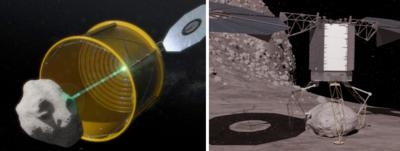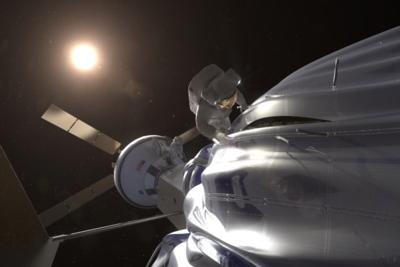Hopes To Capture And Park An Asteroid In Orbit Around The Moon
NASA is continuing to push forward with its somewhat controversial Asteroid Redirect Mission (ARM), looking to add potential candidate target asteroids for the program. The robotic mission will identify, capture and redirect a near-Earth asteroid to a stable orbit around the moon. In the 2020s, astronauts will explore the asteroid and return to Earth with samples. NASA says this will test and advance new technologies and spaceflight experience needed to take humans to Mars in the 2030s.

NASA has two options for robotic asteroid capture. One concept would capture a small asteroid in its "native orbit" – the natural orbit in which it is found. The other would retrieve a boulder from a larger asteroid. NASA will decide between the capture options in December and hold a Mission Concept Review in early 2015, which will further refine the design of the mission.
A lean, agile team of NASA engineers are testing the two concepts, capitalizing on technology and engineering work already underway at NASA. Four industry teams selected through NASA’s recent Broad Agency Announcement also are developing concepts to either enhance this work or provide alternative ideas.
NASA’s plans to announce the target asteroid for the mission approximately a year before launching the robotic spacecraft, scheduled for no earlier than 2019. To date NASA has identified three valid candidates for the small asteroid concept and three for the boulder concept. The agency expects to identify one or two additional candidates each year that could become valid targets for the mission.
Before an asteroid can make the valid candidate list, NASA’s ARM target identification criteria must be met. Scientists must determine the rotation, shape, precise orbit, spectral class, and most importantly, size of the asteroid itself. With the asteroid millions of miles away from Earth, defining these factors requires a series of observations and analysis.
Telescopes on Earth and in space contribute to the observation, tracking and characterization of an asteroid. The process begins by detecting Near Earth Objects (NEOs) and starting to track their orbits. Ground observatories first scan an area in the sky to detect an object moving across the background of stationary stars and report its position in relation to them. The International Astronomical Union Minor Planet Center collects the resulting data and determines if the object has already been identified. If classified as a new object, scientists will be able to have a rough orbit and estimate of the size of the object within a day or two of the initial discovery.
Detecting an asteroid isn’t enough to conclude it could be a good candidate for NASA’s asteroid mission. Scientists need to further understand an asteroid’s shape, size, spin rate, and even surface features when picking a candidate. The best way to precisely measure these characteristics is with interplanetary radar, but only if the object is close enough to Earth to be observed this way. When the asteroid is not within the range of radar, the NASA's Spitzer Space Telescope can contribute to the data collection using infrared imaging if the object can be seen by it.
Infrared light is a better indicator of an object’s true size because by measuring its infrared glow the amount of solar heating the entire object re-radiates can be determined. Combining the data collected by Spitzer and ground observatories allows an asteroid’s density and mass to be more precisely estimated. Spitzer’s infrared imaging has enabled NASA to determine the size of two ARM candidates thus far.
The three valid candidates so far for the small asteroid concept are 2009 BD, 2011 MD and 2013 EC20. The size of 2009 BD is estimated to be roughly 13 feet in size, while 2011 MD is estimated to be approximately 20 feet. These sizes are inferred by data provided by the Spitzer observatory. 2013 EC20 is about 7 feet in size, as determined by radar imaging.

Most known large asteroids are too big to be fully captured and have orbits too distant for the ARM spacecraft to redirect them into orbit around the moon. Some are so distant when discovered that their size and makeup are difficult for even our most powerful telescopes to discern. Still, others could be potential candidates but go from newly discovered to out of our telescope range so quickly that there is not enough time to observe them adequately.
There are currently three validated asteroid candidates for the boulder concept, known as Itokawa, Bennu and 2008 EV5. Itokawa was well characterized by close and direct observation on the Japanese Hayabusa mission and is known to contain boulders an ideal size of roughly 10 feet. Both 2008 EV5 and Bennu have been imaged via radar, collecting data from which it can be inferred they have boulders of the appropriate size. In addition, NASA’s OSIRIS-REx mission to launch in 2016 will study Bennu, and conduct detailed mapping of the surface of the asteroid in addition to taking samples and returning them to Earth for further study.
Any asteroid ultimately chosen for the mission will contain remnants of material from the solar system's formation. In the 2020s, astronauts will visit the asteroid for a number of activities, including returning to Earth with substantial selected samples. The results could open new scientific learning about the formation of our solar system and the beginning of life on Earth, inform us about what resources asteroids may contain for use in future exploration, and foster partnerships with industry for future endeavors in space.
(Images provided by NASA. Top: Artists visualization of astronaut studying asteroid. Bottom: On the left, a notional concept image of ARM robotic capture option A, which would envelop an entire free-flying asteroid. On the right, a notional concept image of ARM robotic capture option B, which would retrieve a bolder from a larger asteroid)
 SpaceX to Launch Inversion RAY Reentry Vehicle in Fall
SpaceX to Launch Inversion RAY Reentry Vehicle in Fall Aero-News: Quote of the Day (04.23.24)
Aero-News: Quote of the Day (04.23.24) Aero-News: Quote of the Day (04.20.24)
Aero-News: Quote of the Day (04.20.24) ANN's Daily Aero-Linx (04.20.24)
ANN's Daily Aero-Linx (04.20.24) Aero-News: Quote of the Day (04.21.24)
Aero-News: Quote of the Day (04.21.24)




